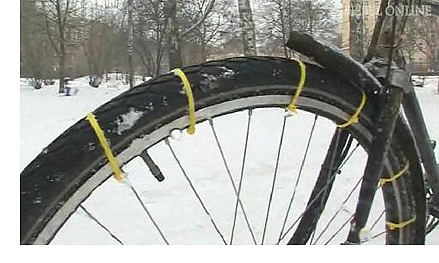If you’re one of the hardy souls cycling undaunted by the current cold snap, doff your cap to the pioneer adventure cyclists of the 1890s who took to the snowy wilds of northern Canada without the benefit of modern clothing and 80 years before the advent of mountain bikes.
The Great Gold Rush in the late 1890s drew 100,000 prospectors to the Klondike region of the Yukon in north-western Canada between 1896 and 1899. Those who didn’t have the money to invest in dog teams used bicycles and rudimentary cold weather gear.

Hardy soul: The front cover of ‘Wheels on Ice’, Terrence Cole’s account of Alaskan cycling at the turn of the twentieth century
19-year-old Max Hirschberg chose to use a bicycle when he joined the gold rush in 1900. His journal gives a fascinating insight into the cold weather gear of the day:
“The day I left Dawson, March 2, 1900, was clear and crisp, 30° below zero. I was dressed in a flannel shirt, heavy fleece-lined overalls, a heavy mackinaw coat, a drill parka, two pairs of heavy woollen socks and felt high-top shoes, a fur cap that I pulled down over my ears, a fur nosepiece, plus fur gauntlet gloves. On the handlebars of the bicycle I strapped a large fur robe. Fastened to the springs, back of the seat, was a canvas sack containing a heavy shirt, socks, underwear, a diary in waterproof covering, pencils and several blocks of sulfur matches. In my pockets I carried a penknife and a watch.”
Twenty-first century winter cycling
Cyclists today have the choice of a bewidering choice of technical winter cycling gear, but if you would rather not spend a considerable amount of money here are a few cheap hacks for staying toasty when the weather turns bitter.
If you have flat pedals, little beats a pair of thick woollen socks and hiking boots. Hardware shops like Toolstation or Screwfix sell these types of boot for around £30 and they can easily be treated with a waterproofing agent. You can make any pair of shoes warmer by adding a plastic freezer bag over over your socks. This stops sweat from carrying heat away from your body (evaporative cooling).
It’s even more effective if you have the plastic against your skin (the insulation provided by your socks stays dry and is more effective), but while your feet will feel warm, the clammy sensation isn’t to everyone’s taste.
For as long as cyclists have braved winter conditions, they have used newspaper as a cheap and effective way to keep warm. Placing the paper under your top is a fantastically effective way to reduce wind chill and at the end of your ride it can be recycled in the usual way.
 It is possible to buy tyres fitted with metal spikes, but these cost around £50 apiece. Imaginative cyclists can adapt their bikes for icy roads by fitting their bicycle tyres with cables ties. The cable ties take only a few minutes to fit and provide impressive traction on even the most slippery of surfaces. The cable ties are inexpensive to buy, and can be fitted without tools in very little time.
It is possible to buy tyres fitted with metal spikes, but these cost around £50 apiece. Imaginative cyclists can adapt their bikes for icy roads by fitting their bicycle tyres with cables ties. The cable ties take only a few minutes to fit and provide impressive traction on even the most slippery of surfaces. The cable ties are inexpensive to buy, and can be fitted without tools in very little time.
Cable ties cost about 3 pence each and each tyre needs around fifteen ties. Once the period of cold weather has passed they can be cut away and discarded. The technique is suitable for bicycles fitted with disc or hub brakes, but the tyres of any type of bike can be adapted for icy road by covering them with pop rivets. The hack costs less than £2 and further details are available for free at the excellent instructables.com
 LED lights have had a transformative effect on cycle lighting. They are energy reliable, efficient, powerful and excellent value for money. Not so much a hack as a money saver, but the best rear light we’ve come across this year is the Cree LED for a very reasonable £7.99 from the Wilkinson website.
LED lights have had a transformative effect on cycle lighting. They are energy reliable, efficient, powerful and excellent value for money. Not so much a hack as a money saver, but the best rear light we’ve come across this year is the Cree LED for a very reasonable £7.99 from the Wilkinson website.
If you team two of these rear lights, you get an effect comparable with set-ups costing ten times as much.
If conditions on the roads get really tough this winter, and if all else fails, you might consider fitting your bike with tank tracks.
Canadian company KTrak sells a snow bike kit that replaces the front wheel of a mountain bike with a ski bade and its rear wheel with a caterpillar track. We tested a Ktrak bike at the SnoZone ski slope in Milton Keynes with mixed results. The blade at the front works better than expected and there’s a good amount of grip from the rubber tank tracks, but there’s a weight penalty and, all things considered, the latest breed of bikes with 29” balloon winter tyres have better all-round ability in snow.
Year-round protection for your bike
Cycle insurance from the ETA offers year-round protection for you and your bike. It includes new-for-old, third party insurance on any bike you ride , personal accident cover, race event cover and if you suffer a mechanical breakdown, we will come out and recover you and your bike.

2 Comments View now